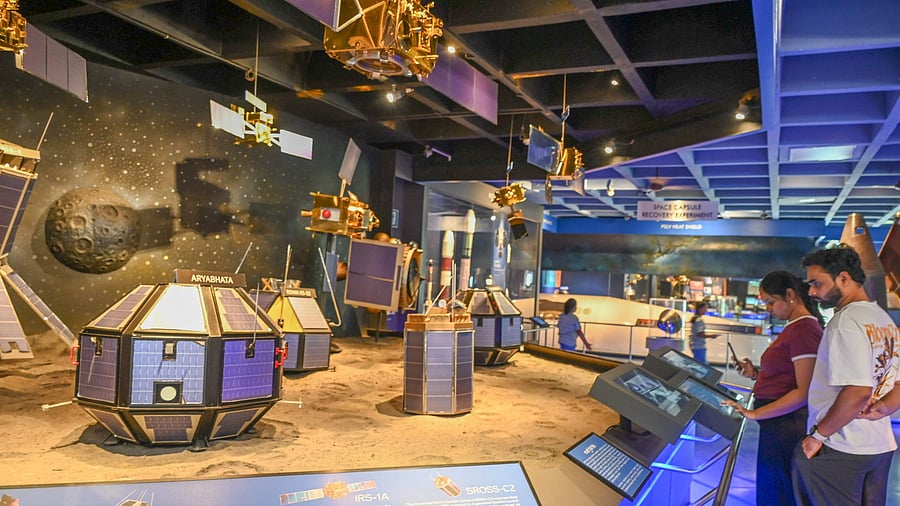
The Visvesvaraya Industrial and Technological Museum (VITM) is India's most visited science museum, attracting nearly three million visitors in the last three years. Meanwhile, Bengaluru's newer museums are intensifying efforts to enhance outreach and increase visitor numbers.
Credit:DH PHOTO/S K Dinesh
Bengaluru: Bengaluru, often hailed as India’s Silicon Valley, channels its innovative spirit not just into research labs but also into its dynamic science museums. These centres ignite public interest and foster scientific discovery.
Prominent among these is the Visvesvaraya Industrial and Technological Museum (VITM), which stands as India’s most visited science museum, drawing nearly three million visitors in the past three years. The recently established Science Gallery Bengaluru (SGB) is quickly becoming a favourite among science aficionados. Alongside these major players, niche museums like the Woods Museum and Interpretation Centre and the Nimhans Brain Museum are making significant strides in enhancing outreach and drawing in more visitors.
Science museums
Science museums play a crucial role in demystifying complex concepts through interactive exhibits and immersive storytelling. Unlike traditional museums that display artifact, these institutions provide hands-on experiences that allow students and visitors to engage with scientific ideas in a tangible way
Civic evangelist V Ravichander highlighted the importance of compelling narratives. “It’s not just about putting up exhibits for people to stare at, read something, and move on. The storytelling aspect needs to be engaging in more ways than one,” said Ravichander, reflecting on the changing expectations of museum-goers, who seek more dynamic and immersive experiences.
Jhanavi Phalkey, Director of SGB, echoed this sentiment, explaining that exhibit selection itself conveys a curator’s intended message. “There is no such thing as just a bunch of exhibits,” she added.
She cautions that prioritising one dominant narrative may overshadow alternative perspectives. Phalkey also stressed the importance of relatable content. “A place like Science Gallery Bengaluru invites audiences to explore the questions that bother them and reflect upon the impact of research in their lives,” she said.
To facilitate this, SGB trains young adults through a “mediator programme” to engage visitors in meaningful, curiosity-driven conversations.
Marketing challenges
Smaller science museums face hurdles in visibility and funding. Ravichander explained that many museums lack the financial resources to promote themselves effectively, resulting in low awareness.
He advocated for modern marketing strategies: “You have to use current marketing tools like a snazzy website and social media. Today, to get your message across, you need to use new-age tools such as social media reels to create virality and interest.” Short, engaging videos, virtual tours, and interactive content are key to capturing the attention of younger audiences and boosting visitor numbers.
Beyond digital marketing, fostering community engagement is essential. Collaborating with schools, colleges, and social organizations can bring in large groups, creating a ripple effect through word-of-mouth recommendations.
“Once you have more people coming in, then by word of mouth, others come in because they hear of it from those who went there,” Ravichander explains. He emphasised the value of curated tours for school and college groups to ensure an engaging and memorable experience.
Dr Anita Mahadevan, a key figure at the Brain Museum, shed light on the power of experiential learning.
“Twice a week, we conduct guided tours for the general public, free of charge. Schools visit by appointment. Students — from the eighth grade onward — get hands-on experiences, such as holding a real brain specimen. Seeing brain specimens affected by stroke, head injury, or infections provides powerful, real-world lessons on health and safety.”
This approach proved impactful, drawing in over 4,000 students and 5,000 public visitors annually, a remarkable leap from fewer than 100 visitors in 2010.
Science Gallery Bengaluru has also seen impressive engagement, with over 8 lakh visitors (both online and in person) in the past four years. Since opening its new premises in January 2024, SGB reported that 34% of student visitors on organised learning tours come from government schools.
Sources in the VITM revealed that the majority of the student-organised trips are from government schools.
Improving accessibility
Bengaluru’s notorious traffic and long distances often discourage potential visitors. To counter this, Ravichander suggests offering multi-attraction packages to create a full-day experience.
“To attract people, especially over the holidays, there needs to be a package where visitors can do three or four activities in the area, making it a day well spent,” he said.
Collaborating with nearby cultural centres, parks, or restaurants could make a museum visit part of a more exciting, well-rounded family outing.
Looking ahead, museums are embracing new technologies to create more immersive experiences.
Dr Mahadevan shared the ambitious vision for the Brain Museum’s expansion into a larger Museum of Brain and Mind, integrating augmented and virtual reality.
“Visitors will be able to see how nerve impulses travel, understand EEG readings, and explore mental health conditions like schizophrenia through interactive exhibits.”
This initiative, backed by government and CSR funding, promises to redefine museum learning experiences.